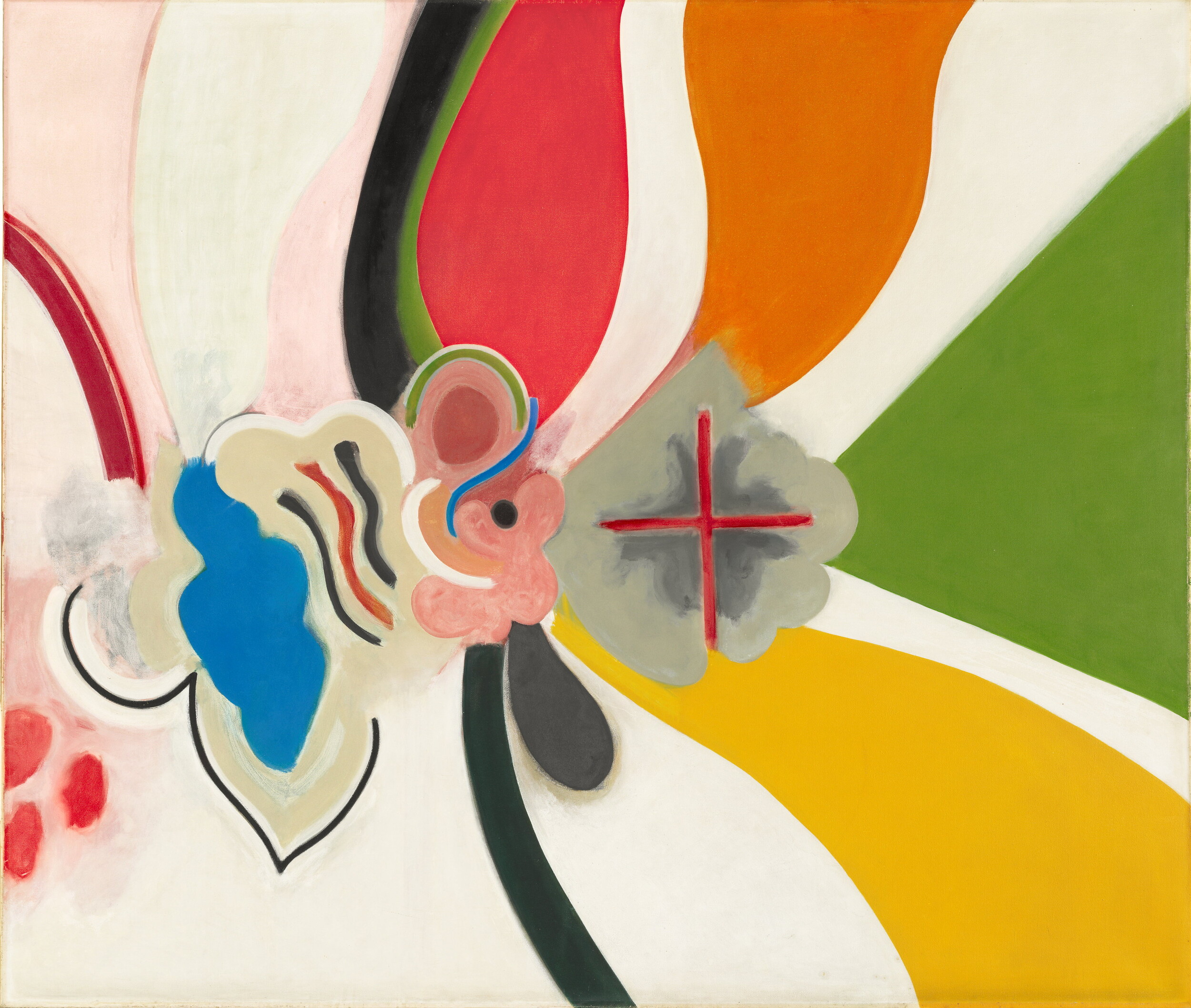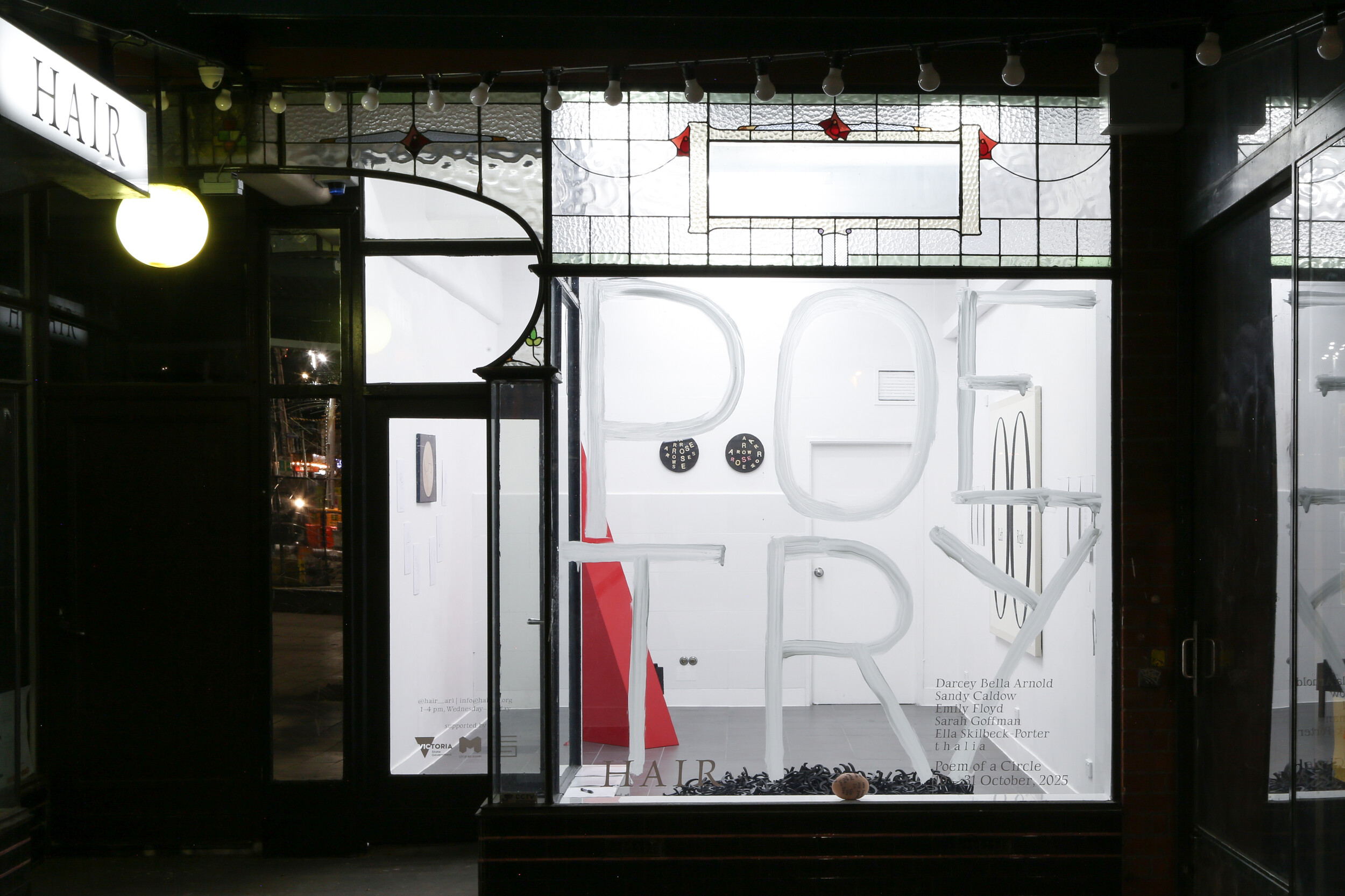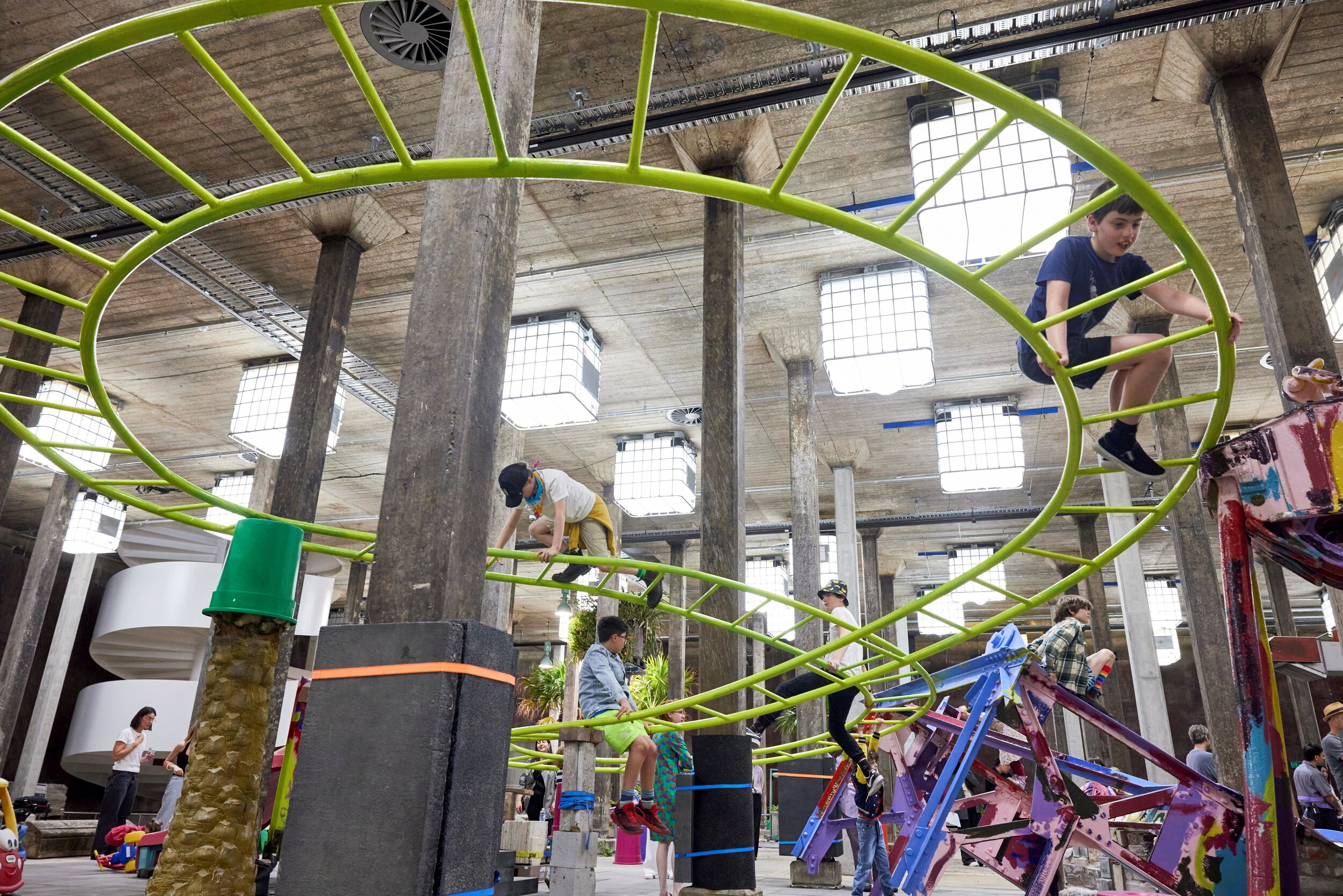Installation view of Lane Cormick, Smoking Will Never Die But You Will, 2025. Photography Astrid Mulder. Image courtesy Linden New Art.
Smoking Will Never Die But You Will
Michael Ascroft
The titular work of Lane Cormick’s retrospective at Linden New Art, Smoking will never die but you will (2010/2025), is a performance/installation from 2010 that was re-performed at the exhibition’s opening. Three young guys, all smokers, in regular clothes but each wearing a black t-shirt, assemble on a white panel on the floor. They dip their hands in a can of lime-green (elsewhere referred to as chartreuse) housepaint. A cigarette has been placed in each of their mouths and there is a lighter available. The test is a simple one, assuming they are keen for the cigarette. Will they wait for the paint to dry before lighting up? Or will they go earlier, guaranteeing smears and drips that will probably half-ruin the cigarette and spot the mouth, chin and clothes in lurid paint? It’s a simple, somewhat devious and entertainingly messy setup, combining a game-show tradition of physical challenges with nicotine addiction. What counts as a win or a loss isn’t clear. One of the performers reports later that in preparation for it Cormick only gave them a short set of instructions. The performers, once involved, likely had to determine for themselves what sort of test it was. After the opening, the resulting drawing—a floor panel covered in painted shoe- and handprints—is displayed in Linden’s foyer.
Smoking will never die is a fitting introduction to this retrospective, curated by Linden director Vincent Alessi. The work picks up on several recurrent themes and strategies that Alessi has identified in Cormick’s practice: ideas about technique and skill, ambition, fame and failure, as well as processes of interaction with others in a spirit of openness and dialogue, and strategies of reworking and reimaging past works. Rather than a conventional retrospective presentation based on a chronology, Alessi has organised this selection of twenty-plus years of Cormick’s works according to a logic of the studio, where the ideas and works from the artist’s back catalogue are presented in various ways: some are displayed in their original form, other older works are re-presented in new, altered form, and these appear alongside new works, which haven’t been exhibited before. The works are also grouped by theme, helping guide the audience towards the main threads of Cormick’s practice.
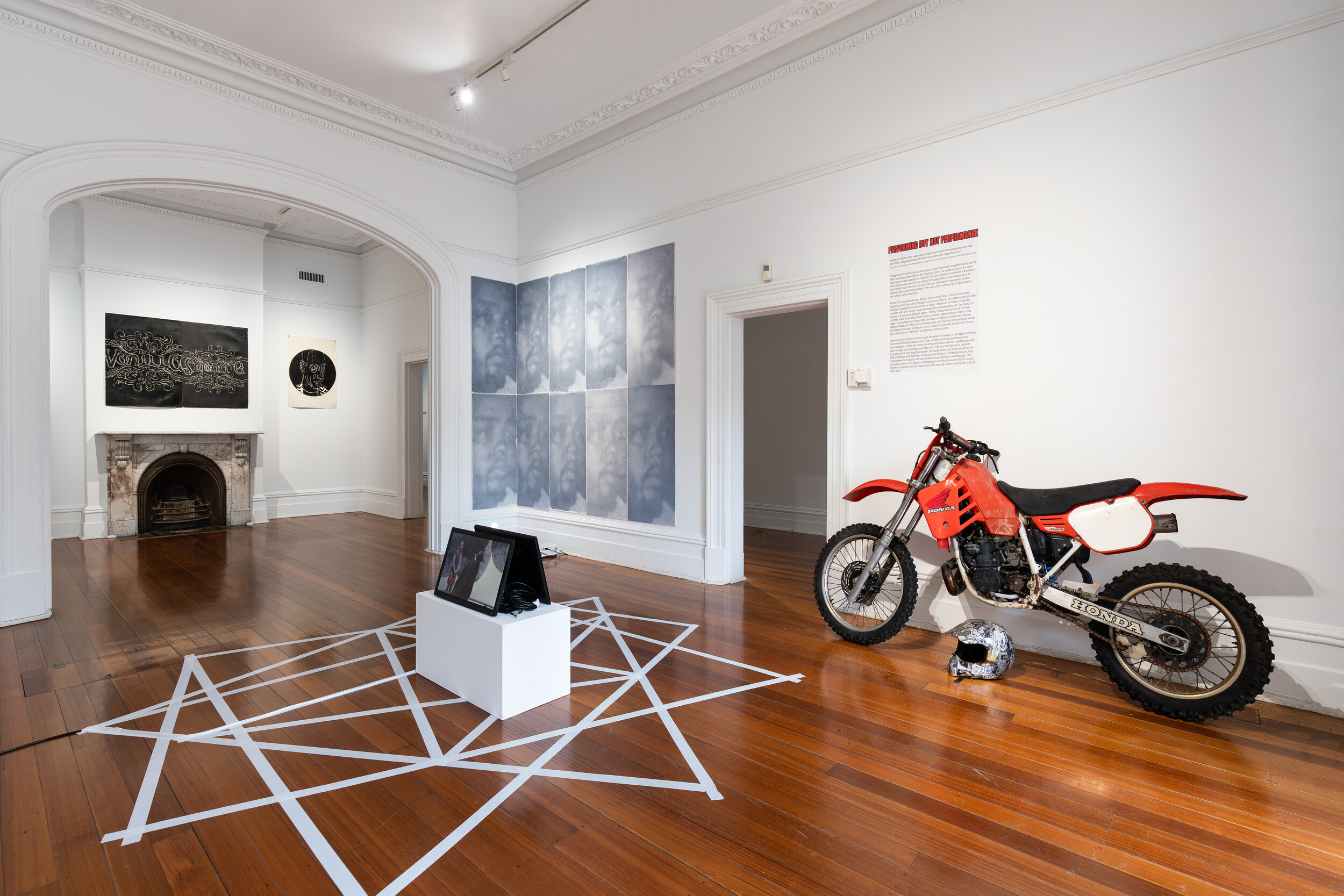
Installation view of Lane Cormick, Smoking Will Never Die But You Will, 2025. Photography Astrid Mulder. Image courtesy Linden New Art.
The first room is focused on Cormick’s early, post-art school experiments with an expanded concept of drawing, followed by rooms dedicated to remnants of performance/installation works, and to collaborations with other artists. Two larger installations are given their own rooms, and there is a series of more recent wall works in the upstairs gallery, while the corridor, stairwell, and a smaller intermediate space also feature works. Alessi’s didactic panels and labels, and a rather formal exhibition layout, also help to orient the viewer within a disorienting range of materials (including videos, text pieces, drawings, remnants of performances, prints, posters, sculptures, and found objects), and the often obscure logic linking form and content.
Real Bos(e) (2010/2025) is a case in point. First shown at Art Forum Berlin, the presentation at Linden re-uses the original latex moulds to create a series of frozen, iced-coffee eagle sculptures. The sculptures are fixed on a square plastic drip tray in the centre of the room with an opening at one corner that allows the melted coffee to fall into a bottle on the floor. A glass-topped chest freezer to one side allows a look at the moulds and the pre-prepared birds awaiting display. On the other side of the room is a trestle table of equipment, including cloths, clamps, and straps, used in the freezing and cleaning procedures. The eagles are allowed to melt away and are replaced the following day.
As the coffee melts slightly faster than the water, it leaves a delicate crust of ice on the eagle’s tawny feathers, beak, and eyebrows. Perhaps plan to get to the gallery earlier in the day to see these subtle and unexpectedly attractive features. Leave it until later and you will more than likely only find a shapeless lump of ice and a pool of coffee in the tray, coffee spattered on the floor, and the grotesquely curdled remains of the previous day’s sculptures in bottles on the mantlepiece.
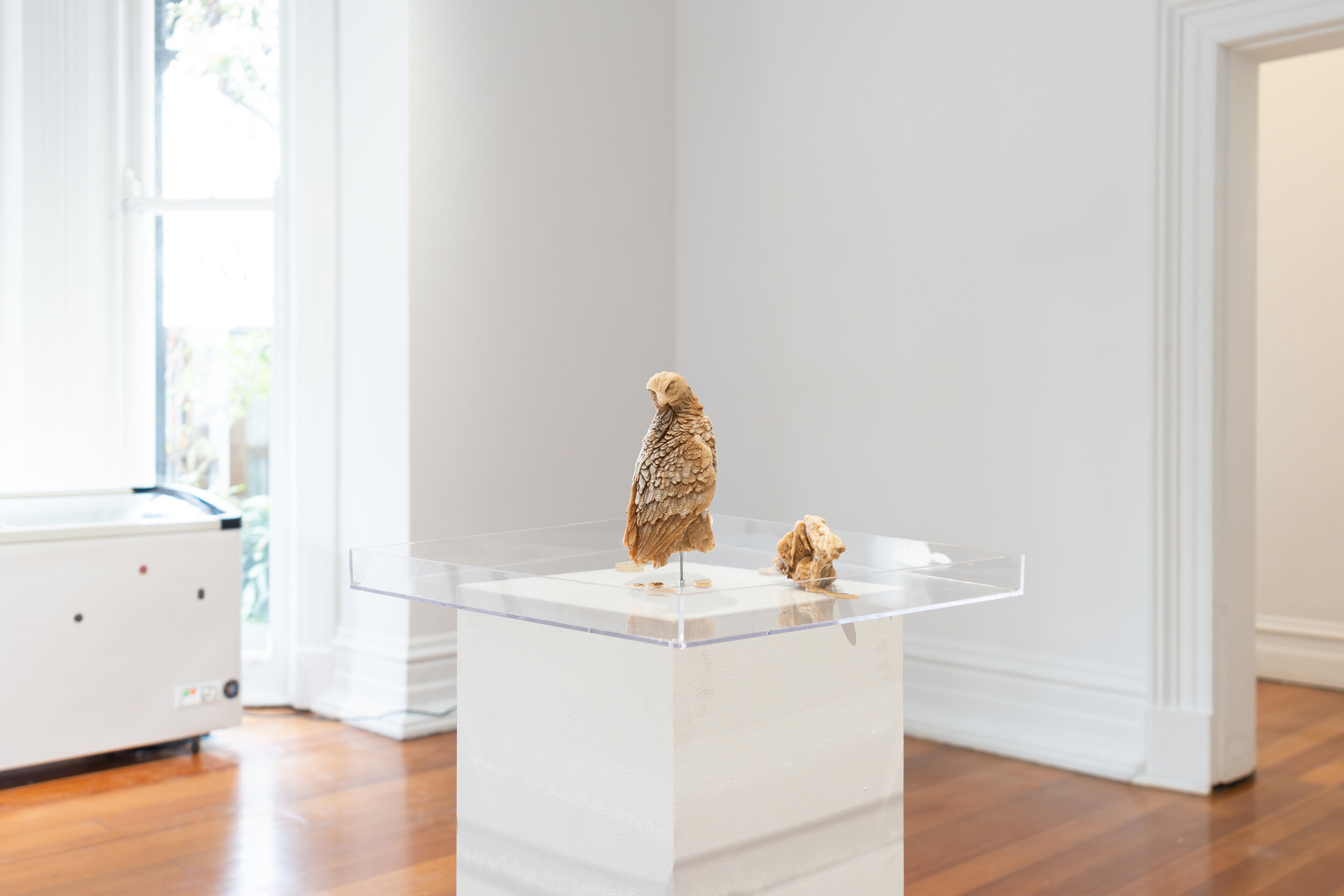
Installation view of Lane Cormick, Real Bos(e), 2010/2025, Farmer’s Union iced coffee milk, freezer, plinth, glass bottles. Photography Astrid Mulder. Image courtesy Linden New Art.
Having conducted a small survey, I can say I’m not the only one who immediately associates iced coffee with tradies. This is not a putdown. An informant tells me it is useful to distinguish between this sugary, lightly caffeinated, cold drink—effectively a milkshake—which goes down well with a pie, and will help sustain a day of physical labour, with the energy drinks better suited to desk work or driving. Rather than taking on the political-symbolic baggage of the eagle as a figure of military might, we might understand the iced-coffee eagle, in its frozen state, as a manifestation of that heightened state of confidence and preparedness to tackle a day of hard work. During the melting process, however, the imposing figure of the eagle dissipates into a gross, comical, puddle. Did Cormick find a visual pun for thermodynamic entropy: the unavailability of a system’s thermal energy for conversion into “mechanical work”? More likely this is the practitioner (and punter) facing the mystery of self-confidence. Unlike entropy, it might be hoped, failure of nerve is not inevitable. In the earlier Berlin version of the work, Cormick wrote “I AM AN EAGLE” in permanent marker on a mini-Jägermeister bottle that held some of the captured drips.
Often, artists who embrace eclecticism in their practices—for example, by shifting in surprising ways between specialist techniques and forms—and who have, like Cormick, a taste for obscurity, tend to produce slick, highly finished works. Cormick doesn’t simply reject this artistic propensity to valorise labour in service of completeness; rather, this is a tendency that his practice is in dialogue with and continually returns to.
While Real Bos(e) articulates a cycle of failure and confidence as a condition of practice, a number of Cormick’s other works, all relating to the Sergio Tacchini sports clothing brand, explore other aspects of this self-confidence problem with forms that have a greater degree of polish. In the upstairs landing at Linden are number of photographic prints on acetate of portraits of glamourous sports stars, including Gabriela Sabatini, Vitas Gerulaitis, Goran Ivanišević, and Ayrton Senna. Hung unframed, they are daubed with thumb-prints of cream enamel paint. Next to Sabatini’s portrait, however, is a photo of an anonymous man on public transport, printed and daubed in the same style. Alongside this series are blurry, black and white close-up prints of a Tachinni fragrance bottle, again on acetate, but covered in punch-out dots and framed. The nostalgic glamour of the portraits is heightened by the hazy, subtle doubling of the images by the shadow of the printed acetate on the wall, and by the painted daubs. To me, these combined visual effects suggest the powerful pull of memory, which Cormick has linked to the affective power of celebrity or star quality.
Thanks to the thematic connections made visible by Alessi’s retrospective display, new aspects of Cormick’s practice are able to come to light. For example, it is clear that his broader interest in artistic personae takes in aspects of gender. Previous interpretations of his work have highlighted the connection between ideas of risk-taking, bravado, and masculinity; but this exhibition demonstrates that charismatic women as well as men are a regular feature of his work. So, while there is the portrait of a crew of balaclava- and white t-shirt-wearing, knife-wielding, beer-drinking guys in Cook Beale Mustard Swan (2008), who performed, or were unleashed, during a lock-in at Neon Parc gallery to an audience outside, there is also Janis (2013), the remnants of a performance/installation featuring Nina Simone. In the original performance Cormick, who was carrying the projector, beamed a section of Simone’s film Live at Montreaux (1976) onto the body of a dancer. Here the projector is aimed into the bottom corner of the room. But in each iteration, Simone paces the stage “projecting” both dominance and vulnerability, the audio repeating the line “if you’ll promise to be my man …” Musicians, as well as artists, sports stars, and other less well-known, but still charismaticc, characters are recurrent objects of fascination for Cormick.

Lane Cormick/Lucina Lane, Lucina Lane Cormick after Miles Davis Love, 2025, acrylic paint. Photography Astrid Mulder. Image courtesy Linden New Art.
The exhibition’s room of collaborative works shows how Cormick has involved other artists in his explorations of the sources of the values that orient his artistic enquiries, and where and how these interests are shared in a multi-generational community of artists. For example, the collaboration with artist Lucina Lane in the large text painting, Lucina Lane Cormick after Miles Davis Love (2025), places the (younger) “Lucina” at the top, “Lane” in the middle, and “Cormick” last, underneath. The work reprises Cormick’s Miles Davis Love (2002), which combined the name of the jazz legend with that of American golfer Davis Love III. Its reappearance here, formalising an intergenerational connection between Cormick and Lane, suggests both fusion and a changeover. By contrast, the collaboration with Rafaat Ishak, Dean Barry (2022), uses symmetry rather than a linear sequence. The work consists of a pair of Yves St Laurent boots and a double portrait of an amateur jockey friend of Cormick’s, and a footballer admired by Ishak when he first encountered AFL. Here, the doubling of boots and portraits seems to stand for parity between the artists.
A third version of this dynamic is the collaboration with Stephen Bram and Torquil Todd, The vanishing point initiates and is its destination; the engine and product. It constitutes the work and is its supplement and remainder (1976 and 2025), which replicates Bram and Cormick’s 2019 collaborative show at Caves gallery. The 2019 show was instigated by Cormick and was based on his memorable early encounter with one of Bram’s wall-paintings while Cormick was an art student. In the current version, Bram has painted a precise, dark-brown rectangle directly on the wall, which frames a collaborative 1976 acrylic painting on board he had done with Todd, the first of a number that the two have completed since. It is a strange, James Gleesonesque figurative painting, featuring a white veiled woman, a naked male figure offering her a yellow chicklet, and a third figure of a spectacled greyhound-man, in a dry landscape with empty dustbins and grey apartment towers against a dreary yellow sky. Cormick’s contribution, Untitled (2025), is a trio of store-bought ceramic statues of the Madonna: the larger figure at the front is draped in a Tacchini tennis jacket, and the two statues flanking her are wearing the brand’s necklaces. Alessi relates that the jacket is the same design as one Cormick was gifted by his father when he was still a school-kid, a luxury item at the time, which he wore to the amazement of his friends. The statues visually echo the Catholic symbolism of the white-veiled figure in the Bram/Todd painting, but ultimately function primarily as signposts for something like devotion, and props for the Tacchini gear, which is the main object of interest. A sequence of practices is traced out in this show-within-a-show: Surrealist painting, hard-edge abstraction, expanded drawing/performance/installation. The inclusion of the Surrealist painting, which is a record of young artists learning and assimilating the practice of one of their seniors, is also a bit of collaborative genealogy that suggests an orientation towards the future as well as the past. The installation poses the question of what form the next generation’s artistic concerns will take, suggesting that the exhibited works will one day look as foreign to them as that surrealistic painting looks to me.
Cormick’s attention to the passage of time, in his intergenerational collaborations and in other works, often has a poignant quality. His works speak to the way that an artwork, even if the artist has in some way failed or been forgotten, outlasts its maker, and because of that might—some uncertain time later—redeem that failure. The portraits of Lee Moses in Janis are one example of this. Another, in a more comic mode, is the run of young artists in cowboy shirts, including the younger Cormick, being thrown one after the other from a mechanical bull in the early video I’m Gonna Buy Me a Horse (2000). Another trace of this theme can be found in the room dedicated to the installation 4/4 (2022), first exhibited at Conners Conners gallery. This work comprises a row of bold, colourful, poster-sized reprints of pages from a collection of the 90s hip hop magazines that Cormick and his late brother both used to enjoy, hung on a black-painted wall. On the opposite wall is a video of a man in a white t-shirt in a white room: this is an early acquaintance of Cormick’s, repeating the names of songs from a Causa Sui album, intercut with brief bursts of a rock band thrashing away in a practice studio. On an adjacent wall are seven gold coins, which feature as an underworld currency in the John Wick movie franchise. Showing a lion and sun insignia, they bear the inscription “en causa sui,” meaning “a being caused by itself.” This introduces an understated but sharp contrast to the innocent enjoyment of the music magazines by Cormick and his brother, which is repeated by the black and white divide between the opposing walls.
Again, in this work Cormick explores an aspect of the artistic persona in which the capacity for self-confidence is ambivalently linked to a capacity for crime as well as artistry, and hints at the fascination and fear that accompanies this. But something else is in the mix as well. Inscribed in biro on the front page of a November ‘92 edition of Hip Hop Connection is his late brother’s name, written by the newsagent who sold him the magazine, not his brother. The reproduction of this smallest of gestures suggests that beneath the explorations of artistic persona there can be many other things besides, such as the commemoration of a simple act of diligence, which can take on a most precious significance, while just as easily going unnoticed.
Michael Ascroft is a writer from Naarm/Melbourne.
